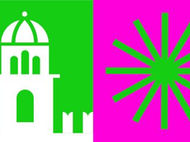Church of the Sacred Heart called “La Baracca”
Church of the Sacred Heart called “La Baracca”
Location: Via Cerkovo n.25 - Milan
Existing from 1957 to 1964
The Church dedicated to the Sacred Heart was known to all the inhabitants of the neighborhood as “La Baracca”. It was a wooden construction built in 1957, located where the nursery school now stands on Via Cerkovo in the Villaggio Bovisasca.
This wooden structure – with walls, roof and floor all made of wood – served as the vital center of the neighborhood for more than ten years.
In addition to religious ceremonies, the bus that transported children to the elementary school on Via Iseo stopped in the nearby square, bordered by rows of poplar trees.
The elementary school on Via Gabbro was not built until 1966.
One of the unique features of this special place of worship was that it was always open: inside, along with the altar, there were statues of the Madonna, Sant’Antonio and Santa Rita da Cascia, statues that are still preserved today in the Church of San Filippo Neri. The church held such a strong religious attraction that children would sometimes ride their bicycles directly into “La Baracca.” Despite this, no incidents of theft or damage were ever reported.


On the facade of the church, on the left side, there was also a bell used to call the faithful to Mass or to the activities of the Oratory. Over time, the bell was later replaced by a scratchy and certainly “unfaithful” phonograph record.
The oratory area was located next to the church and, every afternoon, after finishing their homework, the children would gather there to play.
In the spring and summer months, we played football (there were no basketball or volleyball facilities) on the field next to the Church – now replaced by a parking lot. In the winter months, we played inside the oratory – a wooden structure like the church – engaging in activities such as playing with cards (“a schiaffo”, “a muro”, etc.), tennis table, table football, reading comics and more.
Since there were many children present and not enough rackets, we played ping-pong “around” using our hands as rackets.

On Sunday afternoons, after Catechism, we could watch a film, usually a western or a comedy such as Abbott and Costello, Laurel & Hardy or preparatory films (La Tunica, Francis l’asino parlante, etc.). During the screenings, the children used to eat licorice and castagnaccio (chestnut flour cake) and drink fizzy drinks or chinotto.Both the little church and the oratory were not originally built for the neighborhood’s inhabitants: As we later discovered, there were prefabricated structures used during the war as soup kitchens for displaced people from Milan.
The little church was demolished immediately after the construction of the Church of San Filippo Neri in 1962 while the old oratory continued to serve the community for a few more years, functioning as both a cinema / theater and a changing room for soccer players.The parish priests of the neighborhood during those years were:Don Giuseppe Lazzati from 1954 to 1957 (Parish of Santa Giustina di Affori)Don Piero Uggeri (1917 – 1984) was the religious leader of the Village for nearly thirty years, from 1958 to 1984.
To this day, Don Piero, who was laid to rest according to his wishes in the Church dedicated to San Filippo Neri, remains a much-loved and respected figure The little church of the Sacred Heart, known as “La baracca”, was demolished shortly after the construction of the Church of San Filippo Neri in 1969. However, for some longtime residents, it remains one of the most cherished places in the neighborhood.



Photo donated by the family















